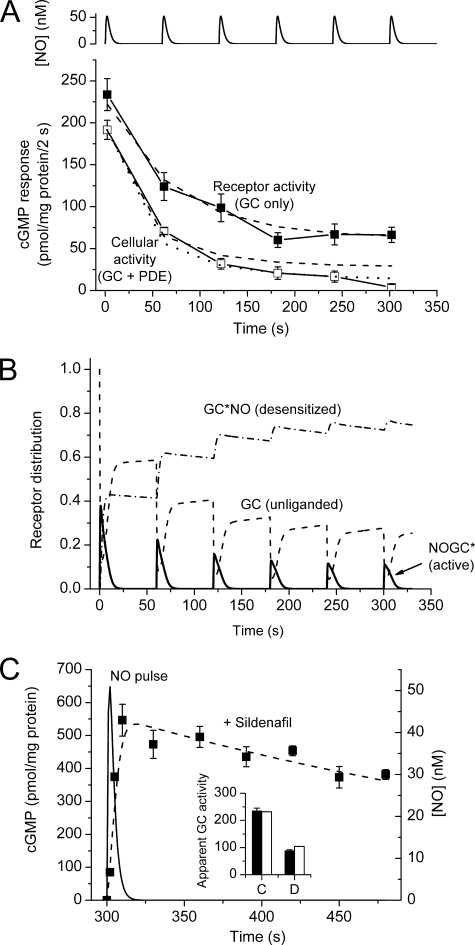FIGURE 1.
Progressive tachyphylaxis after repeated NO pulses. A, pulses of NO peaking at 50 nm were delivered to platelets at 1-min intervals (simulated at the top), and cGMP accumulation over 2 s was measured each minute in the presence and absence of sildenafil (100 μm). Dashed lines are predictions of the model (Fig. 6 and Table 1) with GCmax = 140 μm/s and Vp2 = 90 μm/s and k3 = 1 × 107 m−1s−1. The dotted line providing a better fit to the cellular activity (open squares) is an extended version of that shown in Fig. 6B, in which the active, cGMP-bound form of PDE5 (cGMP-PDE5*) undergoes a transition to a more stable (putatively phosphorylated) state, with forward and backward rate constants of 2 × 10−3 and 6 × 10−4 s−1, respectively. The latter value was chosen to match the 20-min reported half-life of phosphorylated PDE5 (19) and the former to fit the experimental data. B, model predictions for the different states of the receptor accounting for the output seen in A. C, test for the appearance of new PDE activity associated with tachyphylaxis. Platelets given 6 pulses (as in A) have desensitized NO receptors, as indicated by the reduction in cGMP generation during the first 2 s of the last pulse (filled bars in the inset: control response (C), desensitized response (D)). In the main panel, samples of platelets were subjected to the 6th pulse in the presence of sildenafil (100 μm), and cGMP was measured periodically over the next 3 min to assess PDE activity. The dashed line is a fit to the model (Fig. 6 and Table 1) assuming GCmax = 140 μm/s and k3 = 0.53 × 107 m−1s−1, giving the levels of control and desensitized GC indicated by the open bars in the inset. The time-course of the NO pulse is simulated for comparison (solid line).

